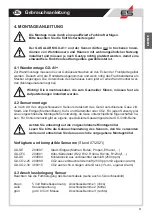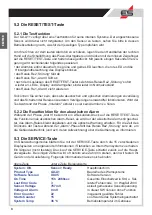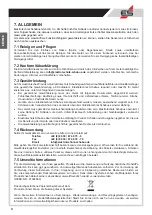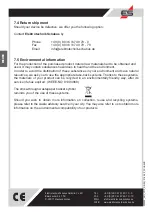
12
EN
GLISH
5.1 This is how the warning system works
The GX-A1+ evaluates voltages supplied by the sensor. In passive sensors, such as the GX-
SE, the gas-sensitive tin oxide is located in a voltage divider, which changes its partial voltage
according to the detected gas concentration. With active sensors such as the GX-CO2-30,
this voltage is generated by a µController.
The following voltage ranges are interpreted and displayed by the GX-A1+ :
Display: top line
bottom line
0,0 ... 0,1V
System: Error Sensor: Broken
Cable break or total sensor failure
0,1 ... 0,3V
System: Error Sensor: Fault
Sensor error, voltage too low
0,3 ... 2,0V
System: OK Sensor: Ready
Monitoring mode, idle
2,0 ... 2,5V
PreAlarm !!! Sensor: 2123m*
Pre-alarm, sensor voltage in mV
2,5 ... 5,0V
Alarm !!!
Sensor: 2789m*
Main alarm, sensor voltage in mV
*
) Exemplary values
And this is how the two relays switch depending on the sensor voltage, with reference to the
normally open contact between connections G and S:
Re1 (Alarm) Re2 (Error)
0,0 ... 0,1V open
open
Re drop off after 10 s. ►5.3 (page14)
0,1 ... 0,3V closed
open
Re2 drop off after some seconds
0,3 ... 2,0V
closed
closed
Relays pick up during commissioning
2,0 ... 2,5V closed closed
Relays remain energized
2,5 ... 5,0V open
closed
Re1 drop off after about 10 seconds
In order to prevent the relays from fluttering in the limit range,
switch always take a time delay of around 10 seconds into account.
This is how the display of the three status LEDs and the acoustic alarm of the built-in piezo
sounder are dependent on the sensor voltage:
OPERATE
ERROR
ALARM
green
yellow
red
acoustic alarm
0,0 ... 0,1V lights up
flashes
off
one beep every 30 seconds
0,1 ... 0,3V lights up
flashes
off
a double beep every 10 seconds
0,3 ... 2,0V lights up off
off
no sounds
2,0 ... 2,5V lights up
off
off
one beep every 10 seconds
2,5 ... 5,0V lights up
off
flashes
interrupted continuous alarm tone
5. COMMISSIONING / FUNCTIONAL TEST
An electrical function test is carried out when the mains voltage is applied, then the heating-
up phase is started for approx. 3 minutes, the display shows
System: OK
and
Sensor: Pre-
heat
until the sensor has reached the required operating temperature, then
Sensor: Ready
Please note: Even in the event of a power failure, the test and the heating-up phase are restarted.


































